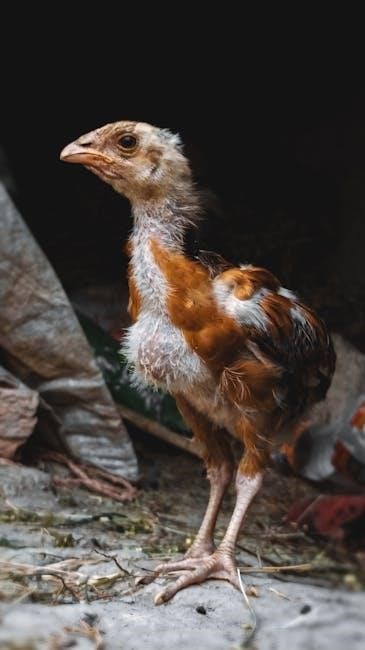Chick embryo development stages commence with fertilization, involving cell division and growth, as outlined in various online resources and pdf documents available for study purposes.
Overview of Embryo Development
Embryo development in chickens is a complex process involving multiple stages, as outlined in various online resources and pdf documents. The process begins with fertilization and proceeds through several stages, including cell division and growth. This development is crucial for the formation of a healthy chick. According to available data, the development of the chick embryo is influenced by various factors, including genetic and environmental conditions. The study of embryo development is important for understanding the biology of chickens and for improving breeding and incubation practices. Researchers have identified various stages of embryo development, and these stages are well-documented in scientific literature and online resources, providing valuable information for students and researchers. The overview of embryo development is essential for understanding the entire process of chick development. Various studies have been conducted to understand this process.
Early Stages of Chick Embryo Development
Chick embryo development starts with fertilization and initial cell divisions occur rapidly within hours.
Primitive Streak Stage
The primitive streak stage is a critical period in chick embryo development, occurring after approximately 18 hours of incubation. During this stage, the embryo undergoes significant changes, including the formation of the primitive streak, which is a linear band of cells that will eventually give rise to the embryonic tissues. This process is characterized by the rapid proliferation and migration of cells, leading to the establishment of the embryonic axis. The primitive streak stage is a key milestone in chick embryo development, marking the transition from a blastula to a gastrula. Further development and differentiation of the embryo will occur in subsequent stages, ultimately giving rise to a fully formed chick. The study of this stage is essential for understanding the complex processes involved in chick embryo development. Various online resources and pdf documents provide detailed information on this topic.

Normal Stages of Chick Embryo Development
Chick embryo development involves sequential stages, as outlined in various online pdf documents and research studies available for reference purposes naturally.
Series of Normal Stages
A series of normal stages in chick embryo development has been identified and documented in various online resources and pdf documents, including research studies and academic papers. These stages are characterized by specific morphological and anatomical changes that occur during the development process. The series of normal stages provides a framework for understanding the complex processes involved in chick embryo development. By studying these stages, researchers and scientists can gain insights into the underlying mechanisms that control development and identify potential factors that may influence the outcome. This knowledge can be applied to improve breeding practices and optimize incubation conditions, ultimately leading to healthier and more robust chicks. The series of normal stages is a valuable tool for researchers, scientists, and poultry farmers alike, and continues to be an active area of research and study.

Embryo Viability and Development
Embryo viability is crucial for successful development, influenced by factors such as temperature and humidity, as outlined in various online resources and pdf documents available.
Environmental Conditions
Environmental conditions play a significant role in chick embryo development, with factors such as temperature, humidity, and oxygen levels affecting viability and growth. According to various online resources and pdf documents, optimal temperatures range from 37.5 to 38.5 degrees Celsius, while humidity levels should be maintained between 50 and 60 percent. Additionally, oxygen levels and air quality are crucial for healthy development, as outlined in studies on chick embryo development stages. The importance of environmental conditions is further emphasized in research papers and pdf documents available online, which provide detailed information on the ideal conditions for incubation and chick embryo development. Proper environmental conditions are essential for successful chick embryo development, and their importance cannot be overstated, as they impact the overall health and viability of the embryo.

Later Stages of Chick Embryo Development
Chick embryo development progresses rapidly with organ formation and maturation occurring during these stages slowly.
Day 14 and 15 of Development
On day 14 of development, the chick embryo undergoes significant changes, including the turning of its head towards the large end of the egg. This movement is crucial for the embryo’s eventual escape from the eggshell. The gut is also drawn into the abdominal cavity, marking a major milestone in the development of the digestive system. During this period, the embryo’s feathers, beak, and claws continue to develop and mature. The formation of these structures is essential for the chick’s survival outside the egg. As the embryo approaches the final stages of development, its overall shape and features become more defined, resembling a small chick. The embryo’s development is almost complete, and it is preparing to hatch. The next stage will be the emergence of the chick from the egg.

Importance of Chick Embryo Development Stages
Understanding chick embryo development is crucial for poultry farming and research purposes, as outlined in various online studies and pdf documents available.
Understanding Embryo Development
Understanding embryo development is essential for various fields, including poultry farming and biological research, as it provides insights into the complex processes involved in the growth and formation of a chick. The study of embryo development can be facilitated through the use of online resources, such as pdf documents and articles, which offer detailed information on the different stages of development. By analyzing these resources, researchers and farmers can gain a deeper understanding of the factors that influence embryo development, including environmental conditions and genetic factors. This knowledge can be used to improve breeding practices and increase the efficiency of poultry production. Furthermore, understanding embryo development can also inform the development of new technologies and strategies for improving chick health and productivity. Overall, the study of embryo development is a vital area of research.
Researchers conclude that studying chick embryo development stages is crucial for advancements in poultry farming and biology fields using online pdf resources and articles.
A comprehensive summary of chick embryo development stages is essential for understanding the complex processes involved in the growth and formation of a chick. The developmental stages are well-documented in various online resources and pdf documents, providing valuable information for researchers and poultry farmers. By studying the different stages, from fertilization to hatching, one can gain insight into the remarkable transformation of a fertilized egg into a fully formed chick. The summary of these stages serves as a useful reference point for further study and research, facilitating a deeper understanding of the biological processes that govern chick embryo development. This knowledge can be applied in various fields, including poultry farming, biology, and veterinary medicine, ultimately contributing to advancements in these areas.
